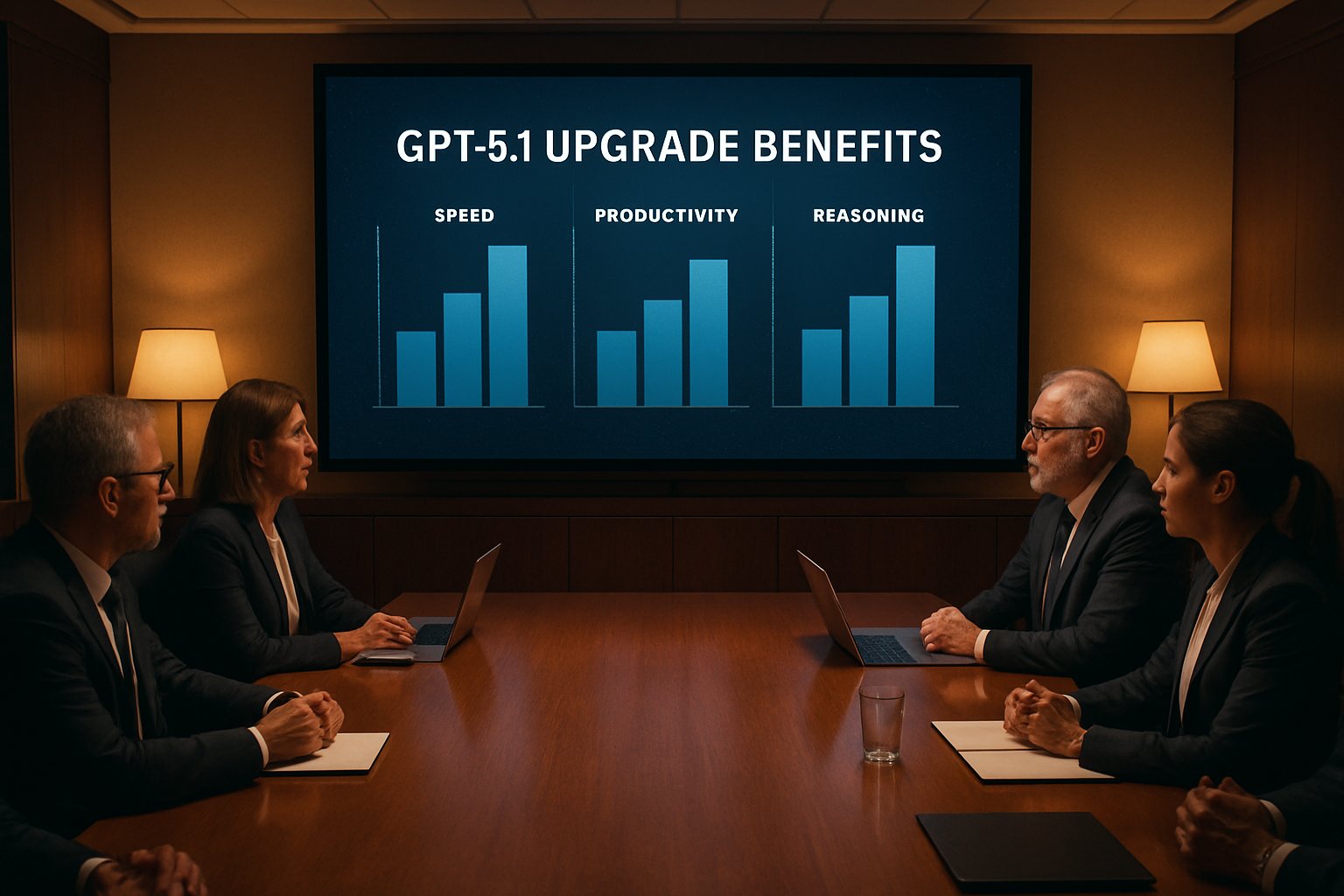
AI CERTS
15 hours ago
What the GPT-5.1 upgrade Means for Developers and Enterprises
Critically, the GPT-5.1 release addresses AI instruction following complaints voiced after GPT-5. Additionally, the company introduced personality presets that persist across sessions, easing user customization. Meanwhile, benchmarks suggest improved reasoning with measurable speed and token efficiency gains. However, early adopters report mixed sentiment on the warmer conversational AI tone. Consequently, leaders must balance performance promises against operational stability and compliance requirements. Therefore, keep reading to understand whether this iteration warrants immediate adoption or cautious observation.

GPT-5.1 Release Timeline Details
OpenAI began the staged rollout on 12 November 2025 for paid ChatGPT subscribers. Developers received API access one day later alongside product documentation. Consequently, early enterprise tests started within hours of release. Microsoft has yet to confirm Copilot integration timelines, yet insiders expect rapid evaluation. In contrast, independent researchers plan external benchmark replication before endorsing migrations. Therefore, the GPT-5.1 upgrade sits in limited release while data accumulates.
Release dates are confirmed and access paths are clear. Subsequently, attention shifts toward tangible feature changes.
Core Model Feature Enhancements
The headline promise involves adaptive computation that scales effort per query. Consequently, users witness improved reasoning on complex tasks without increased latency for simple questions. Benchmarks show 76.3 percent on SWE-bench compared with 72.8 percent in GPT-5. Moreover, the warmer conversational AI style addresses complaints that GPT-5 felt detached. OpenAI also emphasises stronger AI instruction following across multi-turn dialogues. Additionally, new personality presets let customers lock tone, concision, and emoji preferences for every session. Overall, the GPT-5.1 upgrade seeks to adjust tone while boosting intellect.
Adaptive Reasoning Explained Simply
Adaptive reasoning grants the model flexibility to invest extra internal passes when needed. Therefore, trivial prompts exit quickly while mathematical proofs receive deeper analysis. In contrast, the optional “no reasoning” mode disables these passes for sub-second responses. Developers can toggle effort levels through a reasoning_effort parameter in the API. Consequently, balanced latency and improved reasoning become achievable through one endpoint.
Adaptive computation underpins most functional gains. Next, tool expansions reveal practical automation paths.
New Developer Tools Expansion
OpenAI bundled apply_patch and shell tools to extend code editing workflows. Furthermore, apply_patch returns structured diffs that downstream systems can merge automatically. Meanwhile, shell exposes command suggestions executed inside restricted sandboxes and then returned to the model. Prompt caching now stores conversation context for 24 hours, reducing repeated token costs markedly. Consequently, companies running agentic loops report 50 percent faster throughput during preliminary pilots. Early adopters state the GPT-5.1 upgrade minimizes idle time during code refactor sessions. Additionally, robust AI instruction following ensures patches respect coding guidelines set by administrators.
Prompt Caching Benefits Overview
Cached tokens price lower and return instantly for follow-up calls. Therefore, the feature matters for support chat, pair programming, and iterative research. Nevertheless, developers must handle cache invalidation after sensitive context expires. Hence, prompt caching strengthens cost control within the GPT-5.1 upgrade ecosystem.
New tools tighten the feedback loop between generation and execution. Subsequently, performance metrics deserve separate scrutiny.
Key Performance Metrics Analysis
Benchmark data originates mainly from OpenAI internal runs and select partners. GPQA Diamond scores climbed to 88.1 percent, surpassing the earlier 85.7 percent mark. Moreover, BrowseComp long-context accuracy remained stable at 90 percent, indicating no regression. Latency tests highlight two-second median answers for short npm queries versus ten seconds previously. Furthermore, token usage dropped from 250 to 50 in that example, cutting cost sharply. Partners like Balyasny Asset Management claim two to three times faster agent runs. Independent labs should confirm whether improved reasoning holds across adversarial tasks outside vendor demos. Until then, early figures still strengthen optimism around the GPT-5.1 upgrade performance claims.
Evidence points toward enhanced accuracy and efficiency. However, user sentiment will ultimately validate these numbers.
Market And User Reaction
Mainstream outlets praise the warmer conversational AI vibe and smoother chats. Nevertheless, Reddit threads accuse the model of overzealous safety filters and lost creativity. Power users also report unexpected shifts in personality presets after long sessions. In contrast, JetBrains testers celebrate faster code suggestions and consistent AI instruction following. Consequently, the narrative remains mixed, echoing earlier GPT-4 evolutions. For procurement teams, this discord underscores the importance of piloting the GPT-5.1 upgrade with representative workloads.
User opinion diverges based on task and context. Next, safety considerations enter the spotlight.
Security And Safety Updates
OpenAI published a system-card addendum covering Instant and Thinking variant audits. Additionally, the firm expanded evaluations for emotional reliance and mental health scenarios. Moreover, alignment layers were tuned to resist prompt injection without harming AI instruction following. Nevertheless, critics request third-party red teaming before declaring victory. The warmer conversational AI approach could increase user attachment, a risk documented by researchers. Therefore, governance teams must couple improved reasoning benefits with human oversight. Consequently, continuous assessment will determine whether the GPT-5.1 upgrade meets evolving compliance norms.
Safety work continues alongside capability growth. Strategic implications emerge for credentialed professionals managing AI programs.
Strategic Takeaways Moving Forward
Enterprises should first audit latency, cost, and compliance under controlled trials. Secondly, teams may tune personality presets to align brand voice while monitoring drift. Furthermore, documented AI instruction following policies should anchor all deployments. Professionals can deepen skills through the AI Prompt Engineer™ certification. Consequently, staff will leverage improved reasoning safely and effectively. Finally, revisit benchmarks quarterly because the GPT-5.1 upgrade will continue evolving via quiet patches.
Actionable steps reduce uncertainty and enhance ROI. Conclusion follows with a concise recap.
The GPT-5.1 upgrade delivers measurable speed gains, richer personalization, and sturdier developer workflows. Nevertheless, organisations must validate vendor claims through independent testing. Moreover, mixed community reactions highlight the enduring need for transparent change logs and opt-out paths. Consequently, prudent teams will pilot features, enforce safety checks, and train staff on new parameters. Meanwhile, the expanded toolkit promises lower costs when applied judiciously. Therefore, assess your roadmap, engage stakeholders, and iterate quickly. Finally, bolster internal capabilities by pursuing respected credentials and staying informed on subsequent patches.



